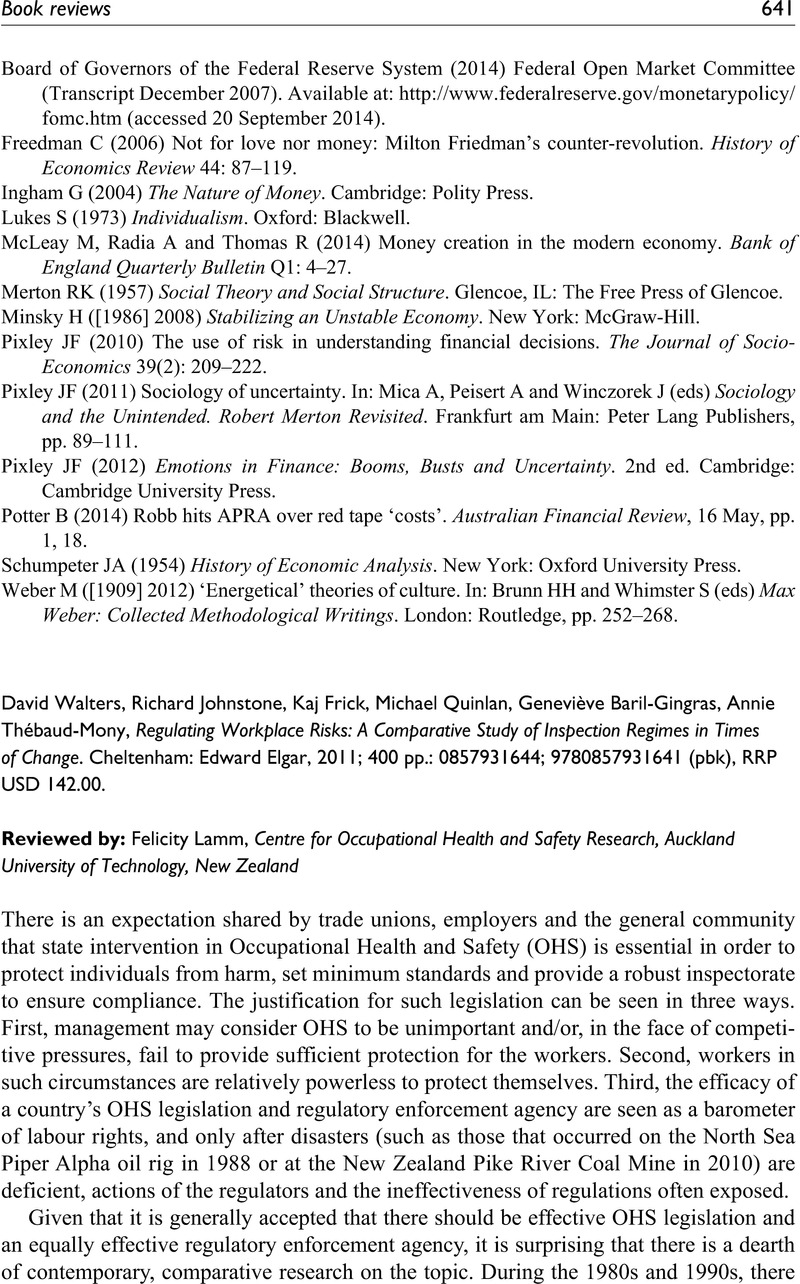No CrossRef data available.
Article contents
David Walters, Richard Johnstone, Kaj Frick, Michael Quinlan, Geneviève Baril-Gingras, Annie Thébaud-Mony, Regulating Workplace Risks: A Comparative Study of Inspection Regimes in Times of Change. Cheltenham: Edward Elgar, 2011; 400 pp.: 0857931644; 9780857931641 (pbk), RRP USD 142.00.
Review products
David Walters, Richard Johnstone, Kaj Frick, Michael Quinlan, Geneviève Baril-Gingras, Annie Thébaud-Mony, Regulating Workplace Risks: A Comparative Study of Inspection Regimes in Times of Change. Cheltenham: Edward Elgar, 2011; 400 pp.: 0857931644; 9780857931641 (pbk), RRP USD 142.00.
Published online by Cambridge University Press: 01 January 2023
Abstract
An abstract is not available for this content so a preview has been provided. Please use the Get access link above for information on how to access this content.

- Type
- Book reviews
- Information
- The Economic and Labour Relations Review , Volume 25 , Issue 4: Symposium: A new global economics? Environment, development, equity , December 2014 , pp. 641 - 645
- Copyright
- © The Author(s) 2014
References
Bartel, AP, Thomas, LG (1985) Direct and indirect effects of regulation: a new look at OSHA’s impact. Journal of Law & Economics 28(1): 1–25.Google Scholar
Braithwaite, J (1985) To Punish or Persuade: Enforcement of Coal Mine Safety. Albany, NY: State University of New York Press.Google Scholar
Carson, WG, Henenberg, C, Johnstone, R (1990) Victorian Occupational Health and Safety: An Assessment of Law in Transition. Melbourne: The La Trobe/Melbourne Occupational Health and Safety Project, Department of Legal Studies.Google Scholar
Frick, K, Jensen, PL, Quinlan, M, et al. (2000) Systematic Occupational Health and Safety Management: Perspectives on an International Development. Oxford: Pergamon Press.Google Scholar
Gunningham, N (1987) Negotiated non-compliance: a case study of regulatory failure. Law & Policy 9(1): 68–95.CrossRefGoogle Scholar
Gun, RT
(1992) Regulation or self-regulation: is Robens-style legislation a formula for success? Journal of Occupational Health and Safety, Australia and New Zealand 8(5): 383–388.Google Scholar
Hasle, P, Zwetsloot, G
(2011) Editorial: occupational Health and Safety Management Systems: issues and challenges. Safety Science 49(7): 961–963.CrossRefGoogle Scholar
Hawkins, K, Thomas, JM
(1984) Enforcing Regulation—Law in a Social Context. Amsterdam: Kluwer Academic Publishers.CrossRefGoogle Scholar
Hutter, B, Manning, PK
(1990) The context of regulation: the impact upon health and safety in Britain. Law & Policy 12(2): 103–133.CrossRefGoogle Scholar
Johnstone, R
(1997) Occupational Health and Safety Law and Policy. Sydney, NSW, Australia: LBC Information Services.Google Scholar
Kagan, RA
(1984) On regulatory inspectorates and polices. In:
Hawkins, K, Thomas, JM
(eds) Enforcing Regulation. Amsterdam: Kluwer-Nijhoff, pp. 67–95.CrossRefGoogle Scholar
Robson, L, Clarke, J, Cullen, K, et al, et al
. (2005) The Effectiveness of Occupational Health and Safety Management Systems: A Systematic Review. Toronto, ON, Canada: Institute for Work & Health. Available at: www.iwh.on.ca (
accessed 20 September 2014).Google Scholar
Scholz, JT
(1984) Regulatory enforcement. Law & Society Review 18(2): 179−224.CrossRefGoogle Scholar
Walters, D, Johnstone, R, Frick, K, et al
. (2011) Regulating Workplace Risk. Cheltenham: Edward Elgar Publishing Ltd.CrossRefGoogle Scholar
Woolfson, C
(1995) Deregulation: The Politics of Health and Safety. Glasgow: Computer Publishing Unit of the University of Glasgow.Google Scholar
Woolfson, C, Foster, J, Beck, M
(1996) Paying or the Piper: Capital and Labour in Britain’s Offshore Oil Industry. London: Routledge.Google Scholar


